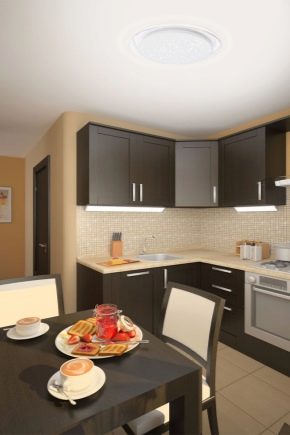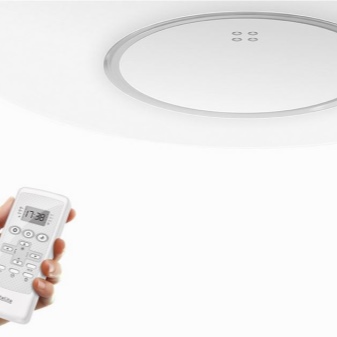Luminaires with remote control

A luminaire with a control panel (PU) is a device that is distinguished by aesthetics, functionality and ease of use. The main advantage of such a device is the ability to adjust the lighting level, turn on and off the lamp without getting up from the workplace or sofa. To increase user comfort, manufacturers also produce touch-controlled luminaires. A feature of these models is a sensor built into the body that changes the level of illumination when you touch the body of the device.



Varieties
Luminaires with remote controllers can be either ceiling or pendant. They differ in the type of installation. Most of the models on the market are ceiling units. They have a compact size, due to which they do not clutter up the space in small rooms.
The devices can be equipped with different types of lamps:
- halogen;
- LED;
- halogen with diode backlight;
- energy saving;
- incandescent lamps.



The most popular among consumers are models with LED light sources. They are distinguished by economical consumption of energy resources, long service life and environmental safety.
Among all LED devices with PU, the model "Luna" has won the greatest demand. The device is a night light powered by finger-type batteries. The model has an adhesive surface. Due to this, it can be glued to both horizontal and vertical surfaces. Luna lamp is a combination of aesthetics, reliability and affordability.

Design features
Externally, devices for lighting with PU are similar to similar lamps. However, they have hidden design features.
All devices have:
- metal base;
- glass or crystal diffusers;
- light source (lamp);
- remote control equipped with a built-in transmitter;
- control unit located inside the metal base of the luminaire.


Manufacturers also offer models with dimmers, thanks to which the user can adjust the light level, creating a comfortable environment for himself. In addition, there are devices with a motion sensor on the market. The sensitive detector, when movement is detected in the coverage area, is triggered and transmits a signal to ignite the lamps. Sensor solutions save energy.
Optional features
The main function of all PU luminaires is to provide artificial lighting in closed areas. Some devices, due to their unusual appearance, have a decorative function. Lamps of bizarre shapes and sizes often become part of the interior. They help to diversify the style, add zest to it, place light accents, and emphasize furnishings.
Also, devices (depending on the model) have the ability to:
- programming the glow period by means of a timer;
- adjusting the intensity of the luminous flux and light of the backlight;
- adjusting the lighting mode (setting the power);
- stroboscopic effect.


Some models have a music center that allows you to play melodies.

Advantages and disadvantages
The main advantage of controlled luminaires is ease of use. In order to turn on / off the lighting equipment, it is not necessary to get out of bed. You just need to press the desired button on the PU.This function is especially important for large rooms where several light sources are located, as well as for people with disabilities.


Luminaires with PU help to quickly create the right atmosphere in the room. With one device, it is possible to provide high-quality lighting for work, study or recreation. It is practical and convenient.
The only drawback of such lighting devices is the big risks of premature failure. The devices are "stuffed" with complex electronics: sensors, dimmers, switches, which often break down. Their rapid wear and tear can be easily explained: the electronic components are located at the base of the luminaire. It is the base that is most susceptible to heating. Electronics is "afraid" of high temperatures and breaks down at the slightest overheating.

Selection rules
Before buying a luminaire with PU, you need to pay attention to the following factors:
- Light source type. The cheapest appliances are equipped with incandescent bulbs. More expensive, reliable and efficient ones are equipped with energy-saving, halogen and LED light sources.
- Power indicators. The intensity of the luminous flux will depend on this parameter. For small rooms (for example, children's rooms), a lamp with an illumination level of 100-150 lux is sufficient, for spacious rooms the indicator should be at least 200 lux.
- Coverage area remote control. Manufacturers produce models with a PU range from 30 to 100 meters (the signal can pass through walls). Any device is suitable for city apartments. For cottages and spacious suburban homes, it is advisable to look at models with a range of 50 meters or more.
- Lighting equipment design (shape, color scale) and dimensions. It is important that the device fits organically into the interior of the room, corresponds to its style.
- Design. For stretch ceiling surfaces, ceiling-type luminaires are suitable. For high ceilings, you can pick up pendant chandeliers.
- Additional functions. Think about whether you need lighting effects, the ability to program the device, turn on the device when motion is detected, and other options. There is no point in overpaying for these features if they will not be used.




There are many models on the market that differ in design, technical characteristics, dimensions and other parameters. Thanks to a large assortment of lighting devices, the buyer will be able to choose the optimal model for himself.

You can see below how to properly connect a chandelier with a control panel.













The comment was sent successfully.